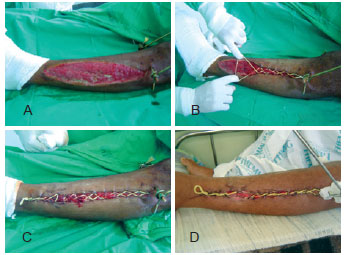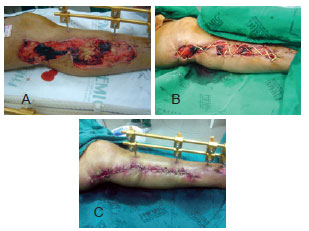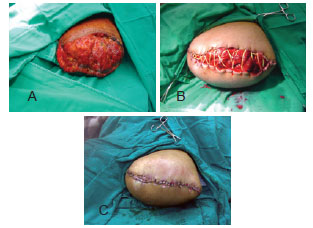

Ideas and Innovation - Year 2012 - Volume 27 -
Elastic sutures for the treatment of extensive wounds
Sutura elástica para tratamento de grandes feridas
ABSTRACT
The suture of extensive wounds remains a major challenge for plastic surgeons. The objective of this article is to promote use of elastic sutures as an effective procedure for the closure of extensive wounds. Fourteen patients presenting with extensive wounds caused by trauma in the lower limbs were included in the study. The entire wound was sutured in each patient with a two-step procedure. In the first step, the opposite edges of the wound were approximated using rubber circular elastic bands. In the second step, carried out a few days later, the elastic bands were removed, followed by a simple suture with monofilament nylon thread. Placement of elastic sutures proved to be a safe, functionally effective, easy-to-perform, and low-cost procedure for the closure of extensive wounds without using donor areas as skin grafts.
Keywords: Wound closure techniques. Suture techniques. Rubber.
RESUMO
O fechamento de grandes feridas continua sendo um importante desafio para o cirurgião plástico. O objetivo deste artigo é a divulgação da sutura elástica como uma técnica eficaz para o fechamento de grandes feridas. Foram incluídos no estudo 14 pacientes portadores de grandes lesões decorrentes de traumas diversos em membros inferiores. O fechamento completo das feridas foi obtido por procedimento dividido em duas etapas, sendo a primeira representada por aproximação das bordas opostas da ferida por meio de tiras circulares elásticas de borracha e a segunda, realizada alguns dias após, com a retirada das tiras elásticas, seguida de sutura simples com fio mononáilon. A sutura elástica demonstrou ser uma técnica segura, funcionalmente eficaz, de fácil execução e de baixo custo para fechamento de grandes feridas, evitando áreas doadoras, como nos enxertos de pele.
Palavras-chave: Técnicas de fechamento de ferimentos. Técnicas de sutura. Borracha.
The suture of extensive wounds remains a major challenge for plastic surgeons. Skin and musculocutaneous flaps (direct, with vectors, or after utilization of skin expanders) are the surgical alternatives more commonly used to close extensive wounds. However, these procedures often provide unsatisfactory results even when performed by experienced plastic surgeons1. Other alternatives rely on the use of bandages to cover the wound until granulation occurs; this is followed by partial or total skin graft. Another option is to treat the wound until spontaneous approximation of the edges occurs or the wound is naturally covered with fibrous tissue.
In 1993, Raskin2 described a suture technique with sterile elastics that avoids creating tension when wounds are closed and prevents the necessity of skin grafts for wounds that are left open.
The objective of this article is to promote placement of elastic sutures as an efficient, low-cost, and fast procedure for the closure of extensive wounds.
METHODS
Fourteen patients presenting with extensive lesions caused by trauma in the lower limbs were included in the study. The patients attended the plastic surgery service of João XXIII and Maria Amélia Lins Hospitals (Belo Horizonte, MG, Brazil) between February and July 2011.
Only injuries that did not allow primary sutures were selected for this study. All procedures were performed for adult individuals (age, 18-52 years; 13 men and 1 woman) who had no comorbidities.
The procedure was carried out in 2 surgical steps. In the first step, a small flap dissection (approximately 2 cm) was performed, and the opposite edges of the wound were approximated using rubber elastic circular bands. The technique consisted of initial suturing with 2-0 nylon thread, which included the elastic and one of the vertexes of the wound. The rubber was then folded across itself to form an X shape. Next, stitches were used to fix each side at both edges of the wound, including the other vertex. Attention was paid to avoid too much pull on the elastic in order to avoid excessive skin tension, even when exposed areas were left open.
Between 7 and 15 days later, once the surgical edges were sufficiently closed, a second surgery was performed, in which the elastic bands were removed and simple suturing with monofilament nylon thread was carried out. The wounds were cleaned daily with saline solution, and an occlusive dressing with gauze soaked in mineral oil was applied.
Figures 1 to 3 illustrate some of the cases in this series.

Figure 1 - In A, fasciotomy of the lower limb. In B, placement of elastic sutures. In C, completion of suturing, with immediate reduction of the wound. In D, almost complete wound closure, a few days after the placement of elastic sutures.

Figure 2 - In A, extensive wound caused by trauma. In B, placement of elastic sutures. In C, the wound a few days after the final suturing.

Figure 3 - In A, thigh stump. In B, elastic sutures. In C, the wound a few days after the final suturing.
RESULTS
In all of the 14 patients, secondary suturing of the skin was performed, with no skin grafts being necessary. Complete wound closure occurred between 7 and 15 days. Upon approximation of the edges of the wound, the skin was sutured with continuous or isolated stitches using 3-0 nylon thread.
No complications were observed in the wounds studied. Patients were discharged the day after the second surgery. Skin sutures were removed between 12 and 15 days after hospital discharge.
DISCUSSION
Although elastic sutures can be used to close extensive wounds, few descriptions of this procedure are found in the national literature. In the past, this procedure was used for the treatment of compartment syndrome of the upper limb, for approximating aponeuroses with rubber elastic bands1.
In a series of 21 patients, Petroianu3 observed complete wound closure in 100% of cases, without the requirement of any other procedures or auxiliary methods. A similar result was obtained in another study, which reported that in all patients where secondary suturing of the skin was carried out, there was no requirement for grafting4.
With this suturing method, treatment costs are reduced. Moreover, this method ensures satisfactory and high quality aesthetic results when compared to those of skin grafting, a commonly used alternative for closing extensive wounds.
CONCLUSIONS
Placement of elastic sutures proved to be a safe, functionally effective, easy-to-perform, and low-cost procedure for the closure of extensive wounds, thus avoiding the use of donor areas as skin grafts.
REFERENCES
1. Cipolla J, Stawicki SP, Hoff WS, McQuay N, Hoey BA, Wainwright G, et al. A proposed algorithm for managing the open abdomen. Am Surg. 2005;71(3):202-7.
2. Raskin KB. Acute vascular injuries of the upper extremity. In: Shaw Wilgis EF, ed. Vascular disorders. Hand Clin. 1993;9:115-30.
3. Petroianu A. Síntese de grandes feridas da parede corpórea com tira elástica de borracha. ABCD Arq Bras Cir Dig. 2010;23(1):16-8.
4. Fansler RF, Taheri P, Cullinane C, Sabates B, Flint LM. Polypropylene mesh closure of the complicated abdominal wound. Am J Surg. 1995;170(1):15-8.
1. Plastic surgeon, full member of the Sociedade Brasileira de Cirurgia Plástica/Brazilian Society of Plastic Surgery (SBCP), president of the Regional SBCP of Minas Gerais, Belo Horizonte, MG, Brazil.
2. General surgeon, resident physician at the Fundação Hospitalar do Estado de Minas Gerais, Belo Horizonte, MG, Brazil.
Correspondence to:
Eduardo Luiz Nigri dos Santos
Av. Pasteur, 89 - conj. 805 - Santa Efigênia
Belo Horizonte, MG, Brazil - CEP 30150-290
E-mail: eduardonigri@terra.com.br
Submitted to SGP (Sistema de Gestão de Publicações/Manager Publications System) of RBCP (Revista Brasileira de Cirurgia Plástica/Brazilian Journal of Plastic Surgery).
Article received: April 5, 2012
Article accepted: June 22, 2012
This study was performed at the Fundação Hospitalar do Estado de Minas Gerais, Belo Horizonte, MG, Brazil.


 Read in Portuguese
Read in Portuguese
 Read in English
Read in English
 PDF PT
PDF PT
 Print
Print
 Send this article by email
Send this article by email
 How to Cite
How to Cite
 Mendeley
Mendeley
 Pocket
Pocket
 Twitter
Twitter